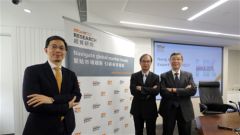ASEAN Consumers Focus on Quality, Style & Online Reviews

HONG KONG — While near-term confidence in major markets has declined among Hong Kong exporters, the outlook for quality, unique style products and services remains bright among the Association of Southeast Asian Nations (ASEAN) markets, according to new research conducted by the Hong Kong Trade Development Council (HKTDC).
“The HKTDC Export Index dropped to 46.2 in the third quarter of the year (3Q17) from a four-year high of 50.1 recorded in the preceding quarter (2Q17),” HKTDC Director of Research Nicholas Kwan said at a press conference today.
“This shows that local exporters have become slightly negative about prospects for Hong Kong’s export performance in the near term,” explained Mr Kwan, adding that “the Index was dragged down by the clothing, toys, jewellery and timepiece sectors.”
The HKTDC Export Index monitors the current export performance of Hong Kong traders and gauges their near-term prospects. Readings above and below 50 indicate positive and negative sentiment, respectively. The United States, the European Union, Japan and the Chinese mainland are markets covered by the Index.
Mainland Most Promising, U.S. Least Encouraging
“By market, a marginal decline in confidence swept across the board,” said HKTDC Principal Economist (Global Research) Daniel Poon, noting that the Chinese mainland “remained the most promising market, while the United States was the least encouraging.”
The mainland, Hong Kong’s largest trading partner, was the only market that stayed above the watershed 50 mark – with a reading of 51.5 in Q317, down from 51.9 in the preceding quarter.
The European Union scored 49.5, followed by Japan with 48.6. The US posted a reading of 47, down from 48.1 in 2Q17 and 50.3 in 1Q17. “While exporters were once positive on the US, in the beginning of 2017, confidence in the market slid down over the course of the year,” Mr Poon said.
The survey also indicates the perceived impact of Brexit on Hong Kong’s export performance continues to fall. The new research found 91% of respondents report “no impact” so far from the United Kingdom’s prospective withdrawal from the European Union. The figure was 86% in 1Q17 and 83% in 3Q16. Only 8% of responding exporters in the latest survey anticipated a negative impact, down from 13% in 1Q17 and 17% in 3Q16.
Meanwhile, the perceived impact of US protectionism under the administration of President Donald Trump on Hong Kong’s export performance also declined. Among respondents, 81% said they saw no impact, compared with 71% in 1Q17. In the latest survey, 18% of respondents expected a negative impact, down from 27% recorded in 1Q17.
“Among the exporters affected in UK and US markets, the majority planned to respond by developing new markets,” said Mr Poon.
ASEAN Consumers Focus on Lifestyle Products and Services
Markets in Asia were also in the spotlight for new HKTDC research looking at consumption patterns in ASEAN cities.
“Travel & Leisure as a spending category was found to be the most popular among ASEAN middle-class consumers,” said HKTDC Principal Economist (Asian and Emerging Markets) Dickson Ho. About 56% of respondents indicated that T&L was among their top spending categories in the past two years. In second place was Health, Beauty & Wellness (36%), followed by Fashion (32%).
“On the other hand, Fashion has the biggest growth potential, with 63% of respondents saying they would spend more on fashion in the next two years,” Mr Ho said. This was followed by Travel & Leisure (54%) and Health, Beauty and Wellness (36%).
The study revealed that ASEAN consumers were spending more on local brands than overseas ones, although there are also opportunities for Hong Kong companies that offer good design and quality.
“The results showed that many Hong Kong brands are well known among ASEAN middle-class consumers, who would like to see more of these introduced to their home countries,” said Mr Ho.
An overwhelming 95% of respondents said they were willing to spend more on products with better quality, while 89% liked “personal style,” said Mr Ho. “These ASEAN consumers also exhibited a great desire to try trendy and novel items, with 83% saying they were always willing to try new brands and products.”
Environmental features, certifications, good design and packaging were found to be among ASEAN consumers’ product selection criteria. “Brands have to create value beyond their core functions to succeed in the ASEAN market,” Mr Ho said.
The survey found that ASEAN middle-class consumers were multi-channel shoppers, with their purchasing decisions heavily affected by online reviews. “At least 50% of respondents have made purchases online or used both online and offline channels,” said Mr Ho.
“More than 50% also reported that social media platforms such as Facebook, Twitter and Instagram had influenced their buying decisions. This shows that Hong Kong suppliers can use social media platforms to market products to ASEAN consumers.”
Survey results also affirmed the proposition that ASEAN consumers regard Hong Kong as a lifestyle trendsetter and a hub for trendy products, while perceiving Hong Kong products and services as being mid-to-high end.
The survey was conducted in the second quarter of 2017, reaching more than 1,400 middle-income class consumers in Jakarta, Surabaya, Bangkok, Kuala Lumpur, Ho Chi Minh City, Hanoi and Manila.
Research Papers:
http://bit.ly/2y7BRh6
http://bit.ly/2h3xsUK
Photo Download:
http://bit.ly/2x3iur7
